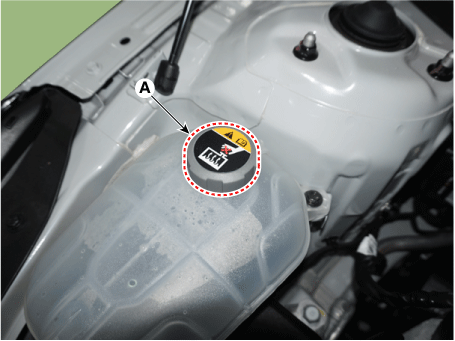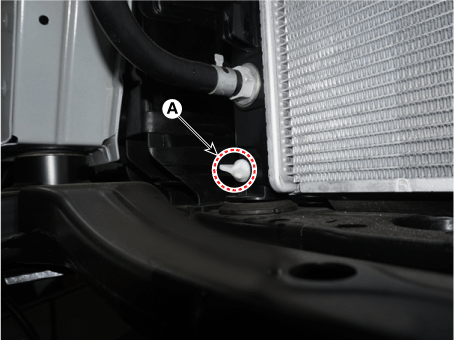Kia Optima: Cooling System / Coolant
Repair procedures
| Refilling And Bleeding |
Never remove the reservoir tank cap when the engine is hot. Serious scalding could be caused by hot fluid under high pressure escaping from the radiator. |
When pouring engine coolant, be sure to shut the relay box lid and not to let coolant spill on the electrical parts or the paint. If any coolant spills, rinse it off immediately. |
| 1. |
Make sure the engine and radiator are cool to the touch. |
| 2. |
Remove the reservoir tank cap (A).
|
| 3. |
Remove the engine room under cover. (Refer to Engine and Transaxle Assembly - “Engine Room Under Cover”) |
| 4. |
Loosen the drain plug (A) and drain the coolant.
|
| 5. |
Tighten the radiator drain plug securely. |
| 6. |
Clean the reservoir tank. |
| 7. |
Fill the reservoir tank with coolant and tighten the reservoir tank cap.
|
| 8. |
Start the engine and allow to come to normal operating temperature. Wait for the cooling fans to turn on several times. Accelerate the engine to aid in purging trapped air. Shut engine off. |
| 9. |
Wait until the engine is cool. |
| 10. |
Repeat step 1 to 9 until the drained water runs clear. |
| 11. |
Fill fluid mixture with coolant and water (55 - 60%) (except for North America, Europe and China: 45 - 50%) slowly through the reservoir tank. Push the upper/lower hoses of the radiator so as bleed air easily.
|
| 12. |
Start the engine and run until coolant circulates. When the cooling fan operates and coolant circulates, refill coolant through the reservoir tank. |
| 13. |
Repeat step 12 until the cooling fan 3 - 5 times and bleed air sufficiently out of the cooling system. |
| 14. |
Fill the reservoir tank to the "MAX" (or "FULL") line with coolant and tighten the reservoir tank cap. |
| 15. |
Run the vehicle under idle until the cooling fan operates 2-3 times. |
| 16. |
Stop the engine and wait coolant gets cool. |
| 17. |
Repeat step 11 to 16 until the coolant level doesn't fall any more, bleed air out of the cooling system.
|
| Inspection |
Radiator hoses
| 1. |
Check radiator hoses for the following:
|
Coolant level
| 1. |
Check the coolant level in the coolant reservoir. Make sure it is between the "F" mark and "L" mark. |
| 2. |
If the coolant level in the coolant reservoir is at or below the "L" mark, add coolant to bring it between the "L" and "F" marks, then inspect the cooling system for leaks. |
Coolant quality
| 1. |
Remove the radiator cap. |
| 2. |
Check if there are any excessive deposits of rust or scale around the radiator cap sub-assembly and radiator filler hole. Also, the coolant should be free of oil. If excessively dirty, clean the coolant passage and replace the coolant. |
| 3. |
Install the radiator cap. |
 Cooling System
Cooling System
Troubleshooting
Engine Overheat Troubleshooting
Inspection
Remedy
Visual inspection
Inspect for shortage of coolant in reservoi ...
 Reservoir Tank
Reservoir Tank
Repair procedures
Removal and Installation
1.
Remove the reservoir tank.
(1)
Disconnect the degassing hose (A).
(2 ...
Other information:
Kia Optima DL3 2019-2025 Service and Repair Manual: Power Seat Control Switch
Repair procedures Removal 1. Remove the front seat shield outer cover. (Refer to Body - "Front Seat Shield Outer Cover") 2. Remove the power seat control switch (A) by loosening the mounting screws. Installati ...
Kia Optima DL3 2019-2025 Service and Repair Manual: Rear Seat Cushion Cover
Components and components location Component Location 1. Rear seat cushion cover Repair procedures Replacement 1. Remove the rear seat assembly. (Refer to Rear Seat - "Rear Seat Assembly") ...




